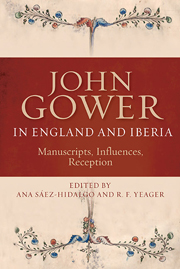Book contents
- Frontmatter
- Contents
- List of Illustrations
- Abbreviations
- Introduction
- I Manuscripts
- II Iberia
- III The Classical Tradition
- IV Economy
- V Reception
- 16 The Long and the Short of It: On Gower's Forms
- 17 “Al université de tout le monde”: Public Poetry, English and International
- 18 Buying Gower's Confessio Amantis in Modern Times
- 19 Gaps and Silences in the Reception of John Gower in Franco's Spain
- Notes on Contributors
- Bibliography
- Index
18 - Buying Gower's Confessio Amantis in Modern Times
from V - Reception
Published online by Cambridge University Press: 05 August 2014
- Frontmatter
- Contents
- List of Illustrations
- Abbreviations
- Introduction
- I Manuscripts
- II Iberia
- III The Classical Tradition
- IV Economy
- V Reception
- 16 The Long and the Short of It: On Gower's Forms
- 17 “Al université de tout le monde”: Public Poetry, English and International
- 18 Buying Gower's Confessio Amantis in Modern Times
- 19 Gaps and Silences in the Reception of John Gower in Franco's Spain
- Notes on Contributors
- Bibliography
- Index
Summary
The history of any book's ownership, its passage from person to person, from place to place, is largely one that has to be reconstructed, not from the evidence contained within the material form of the work itself, but chiefly by reference to external documents. There may, of course, be signs of ownership within the book, annotations, coats of arms, signatures or shelf marks, but these do not invariably appear and often do not occur at all; where they do exist they are not always identifiable and are hence of limited evidential value. Insofar as any book may have a developed provenance record that can be securely traced it is likely to be a record of the details of its commercial history, a record of who paid what for it where, when, and to whom; such a record must be largely retrieved from details in inventories, sales catalogues, and dealers' files.
Recovering such details is fraught with difficulties. It requires considerable skill and a fair bit of luck to establish what a book actually sold for at any point in its history. A published price at auction (the most common means of establishing value) is now likely to be based not just on the actual “hammer price,” that price at which it was actually sold at the conclusion of bidding, but on this figure together with the various buyers' and vendors' premiums that are also charged.
- Type
- Chapter
- Information
- John Gower in England and IberiaManuscripts, Influences, Reception, pp. 279 - 290Publisher: Boydell & BrewerPrint publication year: 2014



